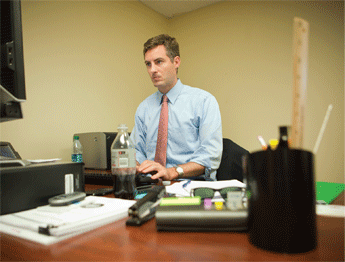Podcast: Peter Meyer interviews John White two days before White takes over as the new superintendent of schools in New Orleans.

A 35-year-old former teacher, John White headed to New Orleans in late April to become superintendent of the Big Easy’s Recovery School District (RSD), quite an accomplishment for such a young man. But, with his bags barely unpacked, he found himself nominated by Governor Bobby Jindal to be interim chief of all of Louisiana’s public schools (thanks to the sudden resignation of Paul Pastorek, who had recruited White), in addition to running RSD. Newspapers claimed that Secretary of Education Arne Duncan was calling members of the state’s school board, praising White as “an extraordinary leader [who is] committed to reform and is a great asset to the state.” Is your head spinning?
John White’s wasn’t. He told the press that he was flattered by Jindal’s offer, that he had come to the Bayou State to run the New Orleans schools, but if they wanted him in Baton Rouge, he’d be glad to help out. Cool. Calm. Collected.
“I’ve got more gray hair than I should at my age,” he says, smiling, during our interview in a first-floor chancellor’s conference room at New York City’s education department headquarters just a few days before he left for New Orleans. Tall, boyish, soft-spoken, White is cordial, even gracious, but never flip. When I ask if we should wave to the mayor, whose “bull pen” office windows were visible from where we sat, he responds that such proximity to the mayor is “a beacon for accountability and the priority that this mayor has placed on public education.” Accountability is a word White frequently used during our talk.
Where did this rising education star come from? The short answer is Teach For America (TFA). He is one of a growing list of wunderkind school leaders produced by this moon shot idea of Princeton University student Wendy Kopp (20 years ago) to put smart college grads in the nation’s worst schools. White, son of a lawyer and “private wealth advisor” father and television journalist mother, grew up in Washington, D.C., and attended the prestigious private St. Albans School, where he learned, he says, “that education starts with relationships between adults and students and among students, who then reinforce the high expectations that are held for them.” But he never thought of being a teacher. In fact, there was a time in high school when he wanted to be a naval officer. As he looks back, he says he was attracted to the military’s “faith to mission, the commitment to excellence because of the deep understanding that they cannot fail.”
Instead of the military (his younger brother and only sibling did become a naval officer), White entered the University of Virginia (UVA), where he majored in English and was aiming at journalism for a career until he discovered an interview of William Faulkner, who had taught at the school, describing Ike McCaslin, protagonist in Go Down, Moses. “There are three kinds of people in the world,” he recalls Faulkner saying. “And I’m paraphrasing. There are people who don’t know there’s a problem. There are people who know there’s a problem and choose not to do anything about it. And then there are people who know there’s a problem and say, I’m going to do something about it. And the power of reading that one night on my couch in my apartment in Charlottesville, Virginia, knowing that it had been spoken only half a mile from where I was living, and amidst this incredibly complex book and this incredibly complex writer and man, but the simplicity of that call literally was a life-changing moment for me. The next day I applied to Teach For America.” And he never looked back.
Into the Crucible
TFA sent White to Jersey City, to 3,000-student Dickinson High School, overlooking the Holland Tunnel, where he taught English for three years and learned that “there are a lot of challenges and we shouldn’t kid ourselves. The school itself was not organized to serve every child. It’s a huge school. Kids come and go. They oftentimes come and go without ever having formed a strong relationship with the adults who are supposed to serve them.” White met “heroic educators who were saving lives,” and he saw quickly “what an impact one teacher could make, and I thought, what an extraordinary thing it would be if we started creating groups of teachers and even schools and school systems that were doing this kind of thing.”
He gives TFA credit for “keeping me in the mission…. We all know each other,” he says of fellow alums like Michelle Rhee (Washington, D.C.’s superintendent at age 38) and Cami Anderson (who took over Newark’s troubled district at age 39), and “those are people who have fueled my commitment just as I hope that I fuel theirs.” After his teaching stint, White went to work for TFA in its New Jersey region coaching and mentoring the new recruits. He was then sent to Chicago to do the same thing. While there he met Arne Duncan. “I count Arne as a friend and advisor and mentor,” he says. “And he once told me, ‘If you want to lead and you want to lead change, just go find a place where it’s happening. Go find a school system where it’s happening and go do it.’”

From the Big Apple to the Big Easy
That was 2006 and the happening place was New York City, where Joel Klein was four years into remaking the nation’s largest public school system. Klein immediately offered White a job on his portfolio planning team, which meant leading the process of closing bad schools and creating new ones, one of the bull’s-eye issues in the massive system’s turnaround efforts. “I was part of the team that was catalyzing change at a very rapid pace,” says White.
Several years later, when Pastorek called and invited him to audition to take over for veteran reform educator Paul Vallas, who was bound for the private sector, White was running the district’s Division of Talent, Labor and Innovation. One of the most important parts of the job was overseeing the Innovation Zone, a network of nearly 100 New York City schools focused on using technology as a catalyst to personalize education. “We wanted to organize schools around the needs of individual kids,” he says. “And I want to emphasize that last point. I think that it’s a question of providing an individual education for each child, which doesn’t mean education isolation, but one where literally every child is having a program daily that is tailored to his or her specific needs.”
As a UVA graduate, White is keenly aware of the groundbreaking work of E. D. Hirsch, who taught at UVA for several decades and is the intellectual godfather of the modern standards-based curricular movement. “Part of the challenge,” says White, “has been a standards-based education that has for too long meant that we don’t differentiate, whereas a child-centered education has meant that we, for too long, don’t hold children to standards.” White believes that “we can marry those two things…. You don’t water down the common core standards; in fact, you adopt them and you implement them.” He knows that technology is no silver bullet, but White believes it will help bring school systems “to where student progress is not being determined by whether he or she sits in a seat for 54 hours or 108 hours, but is instead seeing what each child is capable of achieving in the common core.”
His three years in the classroom at Dickinson High gives White a firm grasp of these fundamental teaching challenges, including trying to teach the same content to a room of children where the proficiency spread may be two to three grade levels. “It is, of course, every teacher’s goal to bring every child to a place of proficiency. On the other hand, we also need to make sure that we’re not holding children back from achieving something beyond proficiency…. Similarly, if a child is just really behind, limiting their education in that subject to 50 minutes makes absolutely no sense.” Part of the problem with the current system, says White, is that “the schedule and the curriculum are organized around a time-based, space-based model.” Technology will help teachers meet children at their level and “move them to mastery.”
White knows that the challenges of running New Orleans’s 70 Recovery District schools are great, despite Paul Vallas’s amazing progress in rebuilding a system that most educators agreed was among the worst in the nation before Hurricane Katrina destroyed more than 80 percent of its 127 schoolhouses (see “New Schools in New Orleans,” features, Spring 2011).
“I think there are three critical challenges in New Orleans,” says White. “One, a system that has moved from tremendous problems to providing an adequate education for many kids still needs to provide a great education for all kids. Two, serving all children, including our hardest-to-serve kids: kids who are over-age, kids with severe learning needs, kids who have been out of school, kids who are moving back. Three, doing it in a way that understands the needs of family, of community, and of parents—that’s critical to being successful.”
A Leader and a Partner
New York—if you can make it here, you can make it anywhere—is certainly a great training ground for meeting and overcoming challenges. And White has the energy and intelligence and grit of a reformer. But as he sees it, the keys to success in the New Orleans RSD, where 37 of the 70 schools are charters, will be “communicating with parents” his “deep belief that parents need to be a partner in education,” that “they need to understand the options for their kids, and the need to make the best choice possible for their kids, knowing what the likely outcome is going to be.”
His responsibility “as a leader,” he says, is “to share information about the opportunities and the constraints that you’re facing. You need to be honest with people about what you can do and what you can’t do. You need to give them a rationale for why you’re doing what you are doing. You need to hear their opinion of the proposal. You need to consider it and you need to be honest with them when you come to a decision…. It’s when we either make promises that we can’t or don’t intend to keep, when we hide from people, when we don’t face the brutal facts, that’s when you know you’re not qualified to be a leader.”
And the one brutal fact that drives this young education reformer is that “without a great education system for all our children, we simply will not be the nation that we imagine ourselves to be.”
Peter Meyer, former news editor at Life magazine, is currently senior policy fellow with the Thomas B. Fordham Institute and contributing editor at Education Next.
This article appeared in the Fall 2011 issue of Education Next. Suggested citation format:
Meyer, P. (2011). The New Superintendent of Schools for New Orleans: A conversation with John White. Education Next, 11(4), 32-34.


